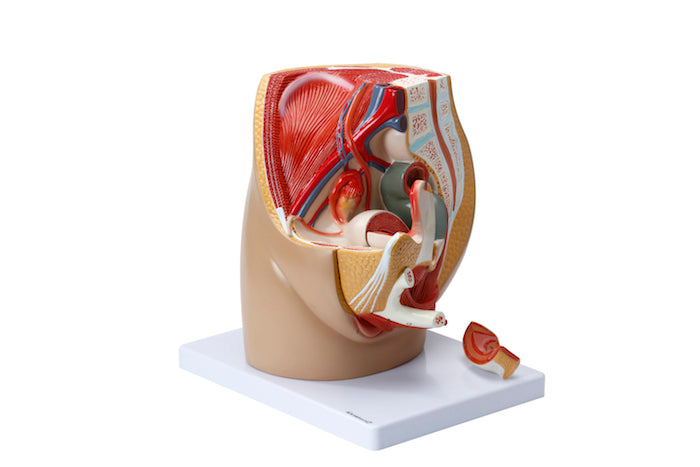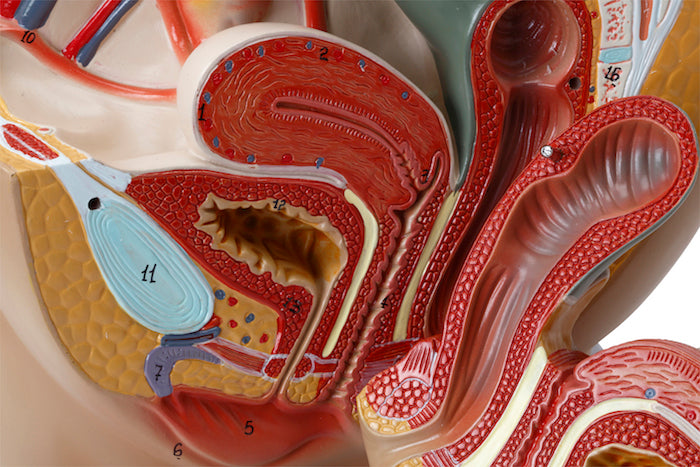SKU:EA1-A580
Model of the internal and external genitalia and relationships to other organs/tissues in the woman
Model of the internal and external genitalia and relationships to other organs/tissues in the woman
5 in stock
Couldn't load pickup availability
This model shows the female pelvis. On the model, the focus is not on the pelvic floor, and the bones that make up the pelvis (pelvic ring). Instead, the focus is on the internal genitalia with their relationships to other organs as well as the external genitalia.
The model is slightly reduced compared to an adult person. Without stands are the dimensions
25 x 23 x 21 cm. It can be separated into 3 parts (see the pictures on the left), which are held together using metal pins. The model is delivered on a stand.
Important anatomical structures are numbered on the model. With the purchase, an overview with naming is included, cf. the mentioned numberings. The naming is only prepared in English.
Anatomical features
Anatomical features
Anatomically, the model shows many different tissues and organs, some of which can be seen in 3 dimensions.
The pelvis (pelvic ring), which consists of bones and the pelvic floor, can only be seen on the model. For example, a cross-section of the symphysis (the front joint) is seen in the pelvic ring. On the other side, some of the large intestine (colon sigmoideum), the rectum (rectum), one ureter (ureter), the urinary bladder (vesica urinaria) with the urethra (urethra), the large artery and vein of the pelvis and parts of their branches can be seen. Ligaments are largely invisible, while nerves are not visible at all (however, the lower part of the spinal cord can be seen - at least the spinal canal).
The median section allows the organs to be seen in detail. In addition, the regions where the excavatio vesicouterina and excavatio rectouterina are formed are seen. On the model, however, you cannot see that they are formed by the peritoneum (peritoneum).
Some tissues/organs are also seen in the horizontal plane (also called the transverse plane) when viewing the model "from above". Here you can see i.a. back and abdominal muscles.
The internal genitalia include the ovaries (ovaries), the fallopian tubes (tubae uterinae), the uterus (uterus) and the vagina (vagina), all of which are seen in detail. Anatomically, it is located in the small pelvis.
The external genitalia are shown with the largest and most important details, which anatomically are located in front of and below the symphysis.
Many of the pelvic organs function as a channel or a reservoir (e.g. the rectum and the urinary bladder), which is why they are seen in a pedagogical way with an air-filled cavity (cavity).
Product flexibility
Product flexibility
In terms of movement, the pelvis is not flexible. The few joints that are visible are not movable.
Clinical features
Clinical features
Clinically speaking, the model can be used to understand diseases and disorders in the woman's pelvis - for example in the genitals, the urinary bladder or the rectum. Examples are anal fistula, anal fissure, urinary tract infection and tumors.
Furthermore, the model can be used to understand disorders and diseases such as stones in the ureter and deep vein thrombosis (DVT) in the pelvis.
Share a link to this product






A safe deal
For 19 years I have been at the head of eAnatomi and sold anatomical models and posters to 'almost' everyone who has anything to do with anatomy in Denmark and abroad. When you shop at eAnatomi, you shop with me and I personally guarantee a safe deal.
Christian Birksø
Owner and founder of eAnatomi ApS





